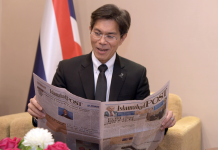By Zhang Niansheng, Liu Hui, People’s Daily
Malaysia-China Kuantan Industrial Park (MCKIP) located in Malaysia, as a model of China-Malaysia cooperation under the Belt and Road Initiative (BRI), has promoted pragmatic cooperation between China and Malaysia and deepened the friendship between the two countries.
Over the past 10 years, the industrial park has borne rich fruits. It has attracted 12 projects with a combined investment value of more than 40 billion yuan ($5.81 billion). These projects have generated industrial output value totaling over 35 billion yuan, created about 5,000 long-term jobs, and contributed an estimated 10 million tons to the increase in the annual throughput of the Kuantan Port, a multipurpose port in Malaysia.
In February 2013, the MCKIP was officially launched in the capitalcityKuantanofPahang state, Malaysia. Located in the East Coast Economic Region (ECER) of Malaysia, the tranquil city of Kuantan is an over three-hour drive away from Malaysia’s capital Kuala Lumpur and adjacent to the Kuantan Port.
The MCKIP, together with the China-Malaysia Qinzhou Industrial Park (CMQIP) situated in China, represents a groundbreaking innovation: the model of “Two Countries, Twin Parks.”
“During the past 10 years, the MCKIP has become one of the most successful industrial parks in the ECER,” said Baidzawi Che Mat, chief executive officer (CEO) of the East Coast Economic Region Development Council (ECERDC).
“The ‘Two Countries, Twin Parks’ model built by Malaysia and China is successful,” he noted.
Alliance Steel (M) Sdn. Bhd. was the first entrant in the MCKIP. It only took 18 months for the project to set up its full-process production line in the industrial park.
With its annual output surpassing the designed annual production capacity of 3.5 million tons, Alliance Steel (M) Sdn. Bhd. has emerged as one of the largest and most advanced steel businesses with full-process technologies for steel products in Malaysia, and its products are sold to global markets.
Steve Hu Jiulin, chief technology officer of Alliance Steel (M) Sdn. Bhd., can still remember vividly the local situation he saw when he first arrived in Kuantan city.
“When I came here in 2014, this place was mountainous and swampy. And the ground works alone took us more than a year,” Hu said.
“Who would think that there used to be a mountain right at the site of the office building,” he said, pointing at the office building where he works.
The premises of Alliance Steel (M) Sdn. Bhd. now boast wide and clean roads and neatly arranged buildings, including office building, factory building, and dormitory.
“The technological design and equipmentof the project of Alliance Steel (M) Sdn. Bhd. are all from China. They are the most advanced ones of the industry,” Hu said.
Hu recalled that during a local official’s inspection tour in Alliance Steel (M) Sdn. Bhd., the official asked as soon as he entered the premises of the company, “Why is this project so clean that it doesn’t seem like a steel mill?”
After learning that the project has followed standards for environmental protection higher than the local standards, and that all the waste heat and gases produced during the production processes are recycled for power generation in a bid to promote circular economy and energy conservation and carbon emission reduction, the official’s eyes widened in surprise.
Alliance Steel (M) Sdn. Bhd. has more than 4,000 employees, among whom most are local people who enjoy much higher salaries than the average local salary.
The east coast where Kuantan city is located is relatively backward in terms of economic development, a local employee told People’s Daily, adding that local people, especially young people, used to go to the relatively developed west coast states of the country for employment.
Now that Alliance Steel (M) Sdn. Bhd. has been settled in the locality, he can work near his home and has significantly improved his quality of life, the young man said.
The development of the MCKIP has boosted investment in Malaysia and China while creating jobs in various fields from production to management, said Baidzawi.
Local contractors and suppliers have also participated in the development of the industrial park, which has benefited a good number of local small and medium-sized enterprises, according to him.
The Kuantan Port is the largest port on the east coast of Malaysia, as well as a pillar for the development of the MCKIP. The Malaysian government has listed it as one of the key ports of the country.
In 2013, the Beibu Gulf Port Group in south China’s Guangxi Zhuang autonomous region became a shareholder of the Kuantan Port, and this China-Malaysia cooperation has brought new vitality to the Malaysian port that enjoys a history of more than 40 years.
The Chinese company, together with the Malaysian operators, jointly upgraded the Kuantan Port and are working to expand the port.
According to Ye Jingtao, general manager of operations of Kuantan Port Consortium Sdn. Bhd. which manages the Kuantan Port, equipment at the new port are all imported from China due to limited local supply. To ensure that the employees can well operate the equipment, the Beibu Gulf Port Group has launched training programs and sent employees to Chinese ports for learning.
Under the joint efforts from both the Chinese and Malaysian sides, the handling capacity of the Kuantan Port has been constantly improved. Its throughput and revenue doubled year on year in 2015. And three years later, it became the largest public port for bulk cargoes of Malaysia and two new 150,000-ton deep water ports were built.
Baidzawi said that the MCKIP and the CMQIP are expected to build more complete industrial and supply chains between Malaysia and China, and deepen their pragmatic cooperation in trade, investment, technological cooperation, tourism, culture and other sectors, as the Regional Comprehensive Economic Partnership has taken effect.


















